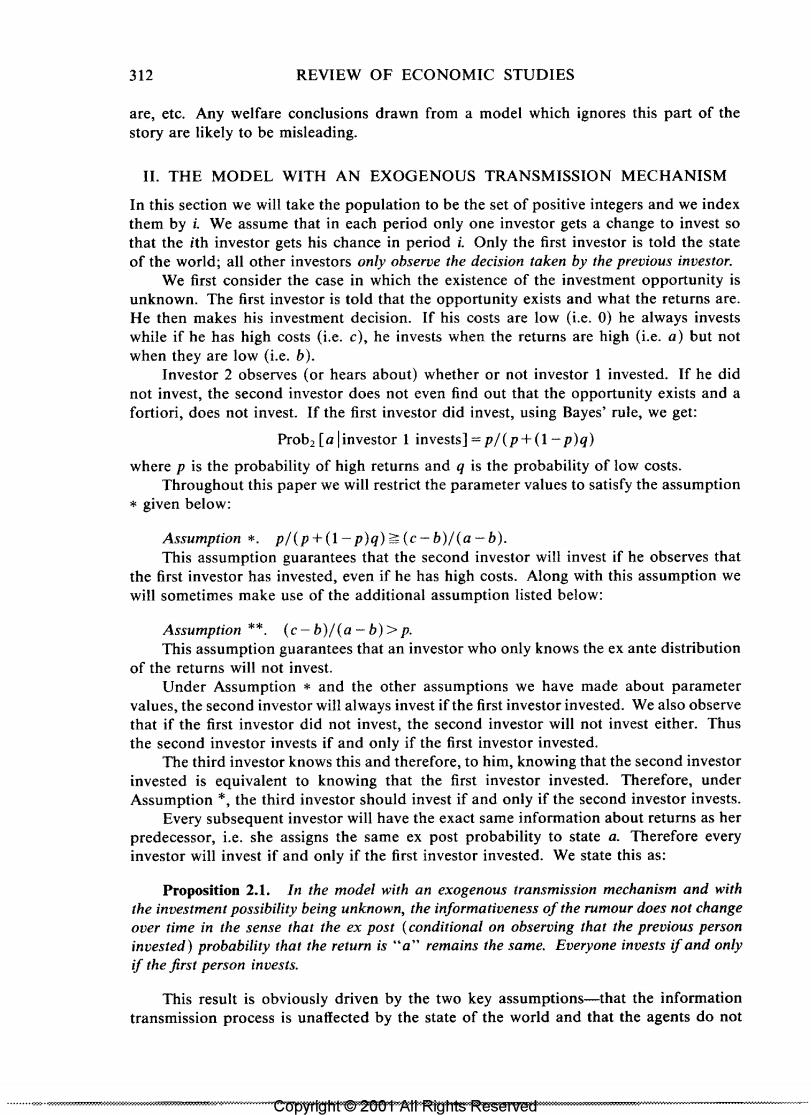正在加载图片...

312 REVIEW OF ECONOMIC STUDIES are,etc.Any welfare conclusions drawn from a model which ignores this part of the story are likely to be misleading. II.THE MODEL WITH AN EXOGENOUS TRANSMISSION MECHANISM In this section we will take the population to be the set of positive integers and we index them by i.We assume that in each period only one investor gets a change to invest so that the ith investor gets his chance in period i.Only the first investor is told the state of the world;all other investors only observe the decision taken by the previous investor. We first consider the case in which the existence of the investment opportunity is unknown.The first investor is told that the opportunity exists and what the returns are. He then makes his investment decision.If his costs are low (i.e.0)he always invests while if he has high costs (i.e.c),he invests when the returns are high (i.e.a)but not when they are low (i.e.b). Investor 2 observes (or hears about)whether or not investor 1 invested.If he did not invest,the second investor does not even find out that the opportunity exists and a fortiori,does not invest.If the first investor did invest,using Bayes'rule,we get: Prob2 [a investor 1 invests]=p/(p+(1-p)q) where p is the probability of high returns and g is the probability of low costs. Throughout this paper we will restrict the parameter values to satisfy the assumption given below: Assumption *p/(p+(1-p)q)(c-b)/(a-b). This assumption guarantees that the second investor will invest if he observes that the first investor has invested,even if he has high costs.Along with this assumption we will sometimes make use of the additional assumption listed below: Assumption **(c-b)/(a-b)>p. This assumption guarantees that an investor who only knows the ex ante distribution of the returns will not invest. Under Assumption and the other assumptions we have made about parameter values,the second investor will always invest if the first investor invested.We also observe that if the first investor did not invest,the second investor will not invest either.Thus the second investor invests if and only if the first investor invested. The third investor knows this and therefore,to him,knowing that the second investor invested is equivalent to knowing that the first investor invested.Therefore,under Assumption *the third investor should invest if and only if the second investor invests. Every subsequent investor will have the exact same information about returns as her predecessor,i.e.she assigns the same ex post probability to state a.Therefore every investor will invest if and only if the first investor invested.We state this as: Proposition 2.1.In the model with an exogenous transmission mechanism and with the investment possibility being unknown,the informativeness of the rumour does not change over time in the sense that the ex post (conditional on observing that the previous person invested)probability that the return is "a"remains the same.Everyone invests if and only if the first person invests. This result is obviously driven by the two key assumptions-that the information transmission process is unaffected by the state of the world and that the agents do not C0 ovriant©200t*t'i帕t竹ts Reserve